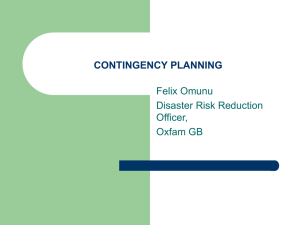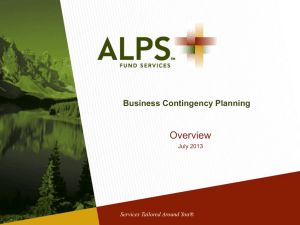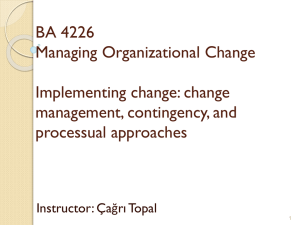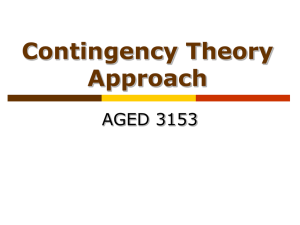Running head: CONTINGENCY PLANNING AND NURSING
advertisement
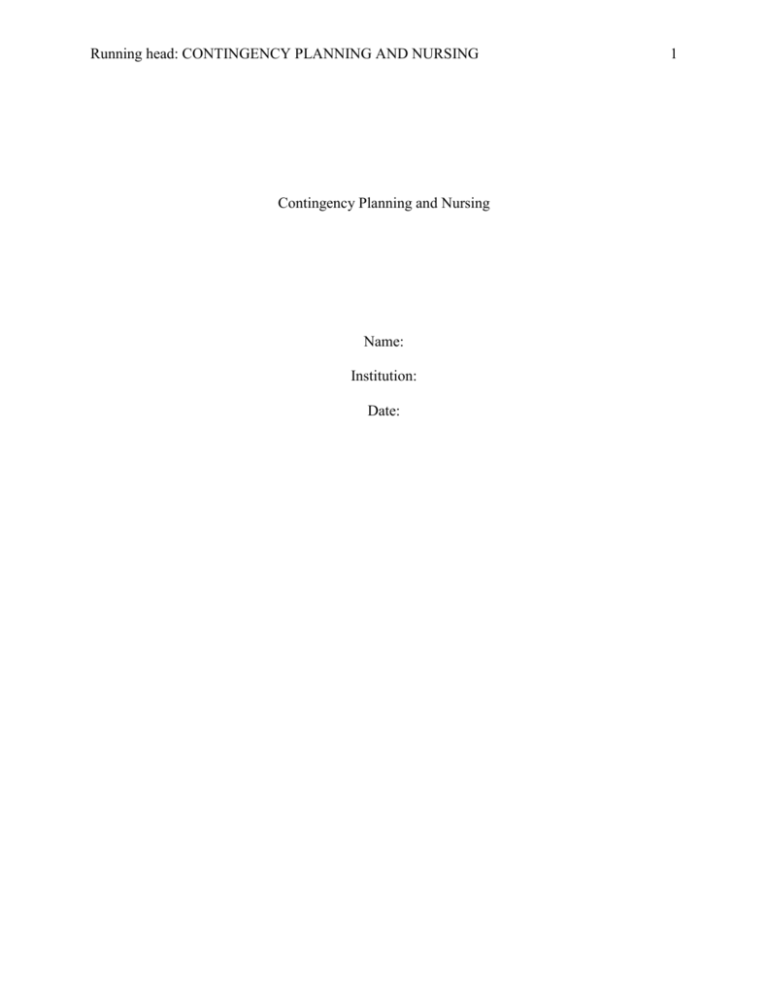
Running head: CONTINGENCY PLANNING AND NURSING Contingency Planning and Nursing Name: Institution: Date: 1 CONTINGENCY PLANNING AND NURSING Contingency planning is a process that should begin as soon as there is an alert regarding an impending natural occurrence. It is important for Gillian to respond quickly to the signal and communicate with its partners early enough to effectively prepare to respond to the stormy situation safely and within the shortest time possible (Westergaard, 2012). Old preplanning can prevent or stop incidents from escalating. The hospital’s command system should be activated early enough to prevent small and preventable incidences from turning into massive emergency situations that can go out of control (Stahl, 2004). All these preparation events should come before the blizzard gets stronger. It means that the security lockdown among other preplanning events should begin as soon as Gillian arrives at the hospital. There is a lack of sufficient time for preplanning; therefore, one imminent challenge is the ability to gather all the effects and mechanisms to run all the activities in the hospital over the blizzard period. There is limited time to collect all the equipment for the entire blizzard period. Another potential challenge is the failure of system machinery due to the intensity of the storm. Storms are unpredictable hence they can become stronger than the preplanning team expects ad escalate to worse levels than expected (Stahl, 2004).. Another challenge during the development of a contingency plan is that people are always poorly motivated in developing a firm alternative plan because of too much emotional investment in the initial plan. There is stress as the alternative plan needs to be thoroughly thought through. The contingency planning is not often seen as important because there is always a low possibility of crisis (Westergaard, 2012). All the working staff within the premises should take part in the preplanning event. Every individual should be allocated tasks so as to reduce the preplanning time. The lesser time for preparation the better preparation it is for the storm. No individual in the hospital premises CONTINGENCY PLANNING AND NURSING should be left out of the development plan. Failure to involve all the people within the hospital might be a weakness if the situation escalates and there is a need for more support. The development plan should also include partners from outside the premises. Because they could offer help in case the situation goes out of hand and cannot be controlled by the people within the buildings (Westergaard, 2012). The contingency plan should be implemented as soon as normal work operations change. In this instance, as soon as the storm begins to show is effects it is wise to apply the contingency plan. The contingency plan is always implemented as soon as the initial plan fails to operate efficiently. All contingency plans should be implemented as soon as there is an alert regarding an imminent crisis (Stahl, 2004). Leaders in this instance should acknowledge the previous contingency plan and its effectiveness as well as its failures. The primary objective of considering the previous contingency plan is to ensure that the weaknesses of the previous program are corrected. It is wise to assess the training results and undertake necessary changes to ensure that there is a limited probability for mistakes. The leaders should revise the plan regularly especially in instances of technological, operational or personnel alterations. The program must be audited periodically and not forgetting considering the risks to the business and preparing for the same (Stahl, 2004). The efforts towards controlling the risks to the hospital and its operations should be well analyzed. Gillian should ultimately recommend changes to the contingency plan if necessary to ensure the accuracy of the program. The nursing team will assess the leadership team based on the values and principles of nursing. The contingency leadership team should conduct their policy and strictly rely on the aspect of patient care during the emergency. The development team should consider the delicate CONTINGENCY PLANNING AND NURSING situation of patients and plan towards avoiding a situation of inconvenience to the nursing team and the patients in the facility. The leadership team will be evaluated based on their leadership approaches and the abilities of the members of their team (Westergaard, 2012). The relationship among the members of the leadership team determines their effectiveness as well as the trust of the nursing team. The manner in which the leadership team allocates its tasks determines their measure of maturity and their skills and methods to meet the requirement of patient care. The leadership team should involve all the stakeholders within the health care facility to ensure all the necessary demands of the contingency plan are in place. The contingency plan should also suit the operations as well as the objectives of nursing (Stahl, 2004). The involvement of all the personnel within and without the installation confirms that the leadership team and the plan can be trusted and is active to the benefit of the health care facility and patient care. The leadership team will also be evaluated based on their methods of operation. The methods of operation should be in agreement with the code of nursing and patient care. CONTINGENCY PLANNING AND NURSING References Direct patient care during an acute disaster: Chasing the will-o-the-wisp. (2005). BioMed Central. Stahl, M. (2004). Encyclopedia of health care management. Thousand Oaks, Calif.: Sage Publications. Westergaard, J. (n.d.). Contingency Planning: Preparation of Contingency Plans. Zoonoses and Public Health, 42-49.

